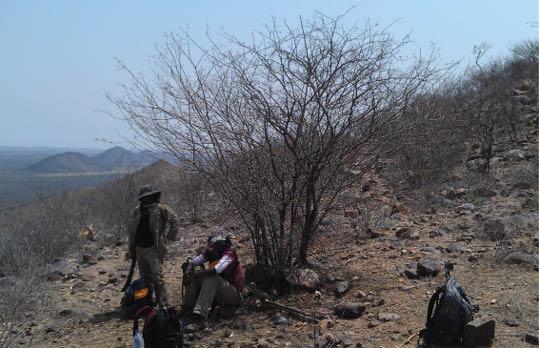10 July 2023

We live in a world where connectivity is an essential part of our everyday existence. Very small aperture terminals (VSAT) play a key role in connecting people and organizations and are vital in remote or rural areas where terrestrial communications infrastructure is scarce or non-existent. One of the benefits of VSAT is that it is independent to local networks so is not affected by blackouts or other shutdowns. The lack of any other kind of reliable communications networks can mean that VSAT systems are literally a lifeline for those people relying on them. It is therefore critical that VSAT sites are well-maintained and functioning properly.

Nimrod Kapon, founder and CEO, Oasis Networks
However, installing, maintaining, and trouble-shooting these sites can prove extremely challenging, precisely because of their location in remote and often hard-to-reach areas. Difficulties arise because of a variety of factors such as limited infrastructure and access to resources, technical issues, cultural and local considerations, limited communication networks, and weather-related issues. These challenges can have a significant impact on a VSAT operator’s ability to maintain a reliable and well performing network. What can operators do to overcome these difficulties so that vital connectivity is maintained, and any downtime minimised?
Limited infrastructure and access to resources
One of the main challenges of maintaining VSAT sites is the physical location of the terminal. With VSAT systems installed in isolated or difficult to access locations, it can be difficult for engineers and technicians to access the site to perform necessary maintenance tasks and carry out repairs. Equally, it can also be problematic to transport supplies and resources to the site when a problem is identified. This is especially complex in areas with poor transportation infrastructure.
It’s not unusual to have to transport equipment by motorbike, all-terrain vehicle, or to trek through waterways and even swamps to reach extremely remote sites. This was certainly the case with one project that we completed in the Democratic Republic of Congo. To get to the site involved crossing the border from Bangui, Central African Republic, then travelling some distance by pickup before carrying equipment by hand over a bridge. We then had to make the last part of the journey to the site by canoe through a waterway. As extreme as this sounds, this sort of journey is fairly typical. This sort of thing obviously results in delays in getting technicians and equipment to the site to carry out installations, testing, and to make repairs.
Technical challenges
VSAT sites can also be impacted by a variety of technical issues, in part because the equipment can be complex and requires specialised knowledge and expertise.
Issues encountered can include antenna misalignment or failure of the modem or other components. These issues tend to be difficult to diagnose and repair remotely, so technicians need to be on-site to troubleshoot and fix the problem. If the equipment fails, it can be difficult to identify the issue.
Technicians need the necessary skills and experience to perform maintenance, testing and repairs. Otherwise, the result is longer downtimes and a reduced level of service for the users of the VSAT network.
Cultural and local considerations
There are obviously huge cultural differences between one region or country, and another. Recognising and appreciating these differences is an important aspect of effectively maintaining VSAT sites. Regulations can differ from region to region, and although less formal, codes of conduct and communication can also differ significantly, and are equally important. Engineers need to adapt how they work, depending on local needs. Local people have inside knowledge and know the best channels to get things done.
When we were working on a project installing a repeater in South Angola, we used a map to identify a mountain location that looked to be a good place for the installation. That mountain also happened to be a holy place for the Mocabashi community, so we had to seek their approval before progressing with the installation. We also had to rely on the Mocabashi community to help us hike up to the summit of the mountain so that we could test coverage. What’s more, to ascend the mountain, we had to work with the Mocabashi people and use machetes to cut our way through the spined trees.
Working with local people is what makes things happen quickly. This is true whether the site is remote, or easier to access such as when situated in a bustling city, as some VSAT sites are. Having strong local connections makes it easier to locate necessary resources such as materials, tools, workers and even specialists like welders. Failure to go through the right local channels can at best, create significant barriers and delays, and at worst, cause animosity and tension, which can prevent a project from being completed.
Limited communication
It’s common for there to be limited or unreliable communication at the remote VSAT sites, as well as when on route to the sites. This can make it difficult to get updates to or from the main office. There have been times when engineers have had to travel across difficult terrain by four-wheel drive vehicles or motorbikes and lines of communication have gone down for days on end because there has been no GSM signal. If vehicles break down or other crisis happens, without GSM signal, there is often no other way to communicate the problem back to base, so engineers are reliant on local people to help them resolve the issue.
Weather-related issues
Weather can be problematic for satellite services, with rain fade and weather attenuation both impacting on service delivery and quality. Weather-related issues don’t stop there. For VSAT sites in areas with extreme temperatures or severe weather conditions such as high winds, lightening, and heavy rain, there are additional challenges to overcome. VSAT systems are often installed in areas where they are exposed to the elements, such as on rooftops or in open areas. This can make them vulnerable to damage from wind, rain, and other extreme weather. These conditions can not only damage the terminal and associated equipment causing disruption to service, but in the event of weather-related damage, can also make it more difficult for engineers to reach the site to carry out tests and repairs.

Many regions have a wet season and during that time, travelling can be very complicated. Roads that are drivable by vehicle for much of the year can quickly turn impassable after a deluge of rain. These kinds of issues need to be taken into consideration when planning deployment because what might look like a reasonable straight deployment when planning on paper, can become significantly more complicated when weather is factored in. In Angola, we helped a customer to plan its deployment better, to consider local knowledge about how the rainy season would advance. It made sense to start in the north and then rush to the south, in a race against the rain, before roads turned impassable.
Boots on the ground
To overcome many of the challenges associated with accessing and maintaining the equipment at these hard-to-reach sites, service providers often rely on a network of local technicians who are familiar with the local environment and can access the site more easily. Having boots on the ground in this way rather than relying on engineers travelling from another part of the world really makes a huge difference. Not only are you saving on travel time and costs, but you are also able to take advantage of local knowledge which gets things done quicker and more smoothly.
Local teams can be trained to perform all aspects of installation and maintenance tasks, such as cleaning the antenna, checking and replacing cables, and troubleshooting and repairing issues with the terminal. Using local teams in this way doesn’t mean that quality is compromised. Providing local engineers are fully supported, trained well and an effective QA system is in place that facilitates continuous improvement, high standards can be maintained across all locations and regions. Using local teams also has a positive impact on their communities because by empowering them to improve community wide access to information and communication technologies, they are also helping to close the so-called digital gap.
VSATs play a vital role in connecting people and are an essential part of our modern communication infrastructure. By making use of local teams, and engaging closely with local people, VSAT operators can keep networks connected and ensure maintenance and troubleshooting of those hard-to-reach areas is done efficiently.






